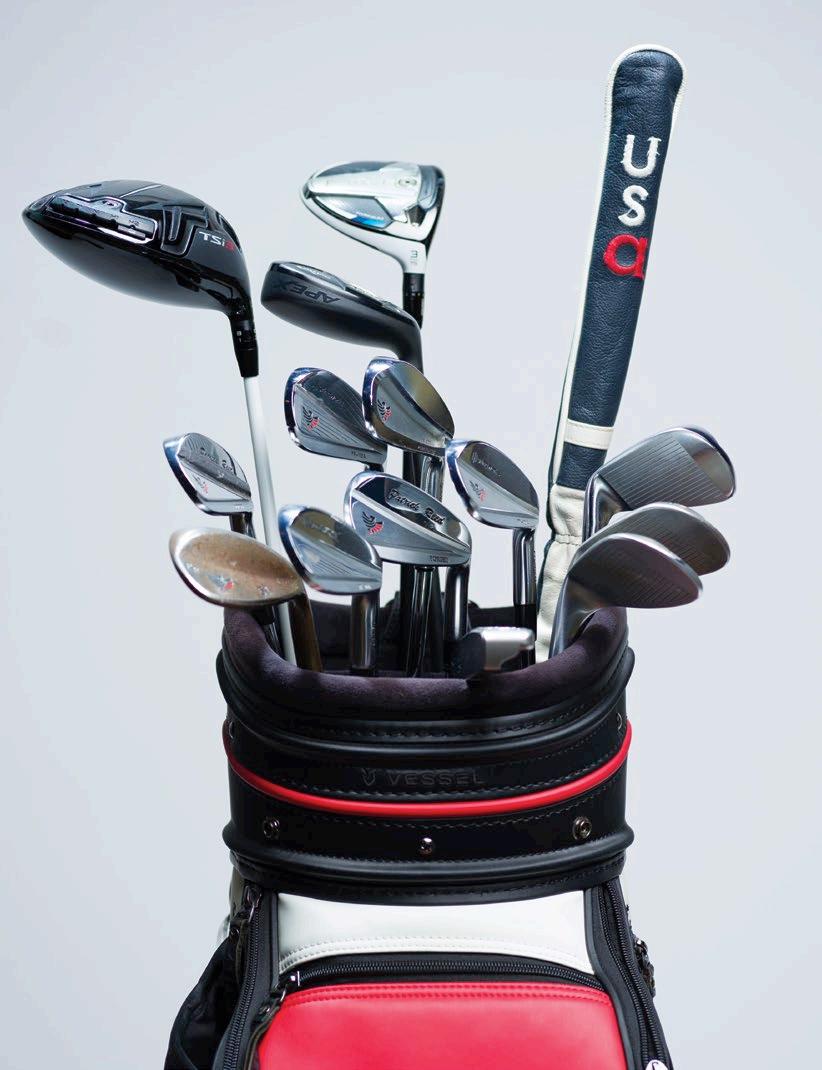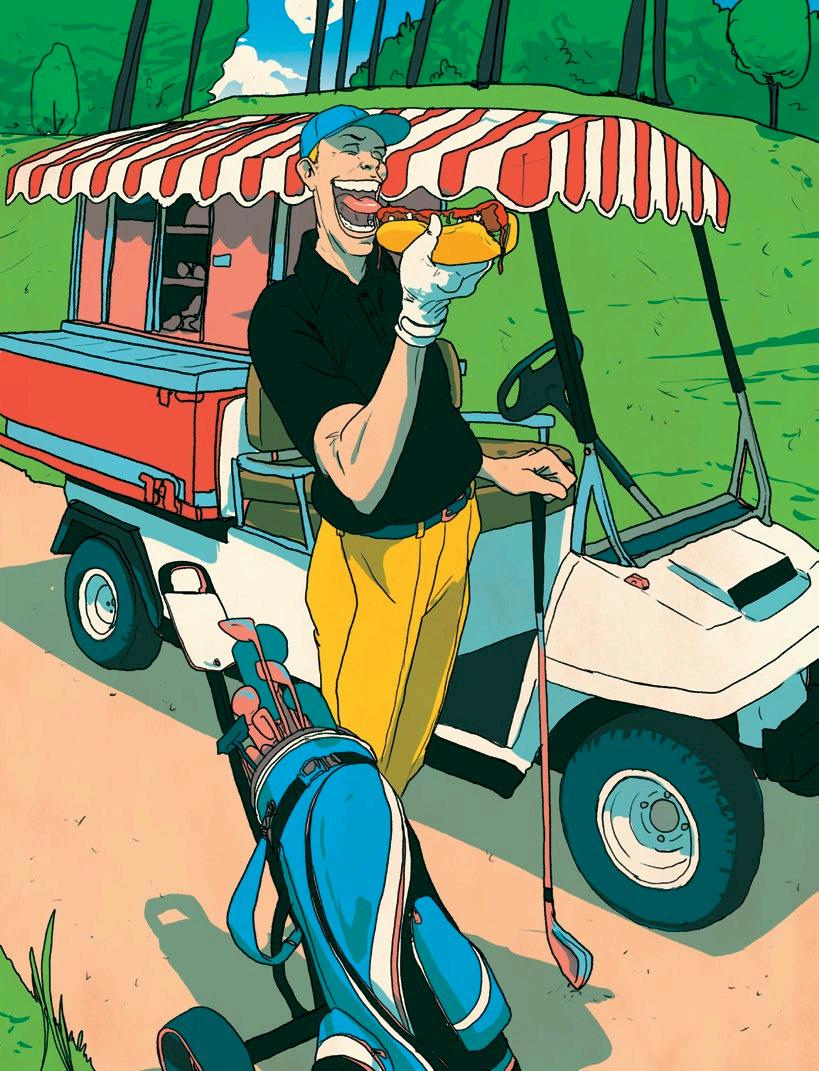
17 minute read
Learn From the Best
S SSS
Swing coach David Leadbetter likes the nickname Magic Hands for his student Patrick Reed, citing his ability to visualise and create short-game shots that most can’t. It might seem like hyperbole—even blasphemy— to compare Reed’s wizardry to that of the late Seve Ballesteros, perhaps the best short-game player of all time, but there are similarities.
“There’s a conventional wisdom about how to execute these shots, but just like Seve, Patrick does it his own way,” Leadbetter says. “He sees what he wants the ball to do, and then his body and hands make it happen.” Reed says his short-game prowess was borne out of necessity. Decades ago, his full-swing shots could be described as an all-out assault on the golf ball, which left him in some exotic places on the course. Without skill around the greens, his pro career wasn’t going to amount to much.
Acknowledging that countless hours of practice fine-tuned his short game, Reed says anyone can copy some of the things he does without spending all day chipping and pitching. (He will share his advice on the following pages). If you focus on short-game practice when you do fi nd time, you’ll reap a lot more benefit than hitting a bucket of balls, Reed says. “It’s three-fourths of my practice time,” he says. “The better you get with this area of your game, the easier it will be to turn 5s into 4s, 4s into 3s and 3s into 2s.”
Rather than set up with his body open in relation to the target— common advice for short shots, Reed addresses the ball with his right foot set back (right) and his shoulders square. “This helps me swing down on a shallower path from the inside, and with the face slightly open, the clubhead will glide along the grass,” he says. “Most amateurs will fi nd this setup more forgiving.” Reed says his closed stance also makes it easier to favour the front foot throughout the swing— key to crisp contact. “You want to keep at least 60 to 65 percent of your weight on the front foot. Your lower body should be very stable with little movement.” From an open stance, amateurs tend to hang on their back foot and move their lower body too much. That makes it tough to consistently hit down on the ball and then brush the grass, he says. Another way to improve consistency is to alter your setup—not your technique—to produce diff erent shots, he says. Reed narrows his stance and plays the ball back for lower-trajectory chips and pitches that have checking spin and widens his stance and plays the ball increasingly forward to raise the height. “But my sternum is always ahead of the ball at address, and I feel comfortable,” he says.

the swing: release the club correctly
“No matter the shot—long, short, high or low—you’ve got to keep your chest moving, especially toward the target before and a er the ball is struck,” Reed says. The rotation of the upper body allows you to release the club correctly, he says. A common mistake is to stop turning at impact while the arms and hands keep swinging. That leads to poor contact and unpredictable trajectory. The club, arms and body should move together in the through-swing. “The right hand is working up through impact, which keeps the clubface pointing toward the sky,” he says. “But if the body stops, you’ll likely blade the shot. You don’t want to fl ick at it; you want to turn through it.”
AIM SMALL, MISS SMALL “When chipping, I’m always trying to get the ball to hole out like a putt at normal speed. You should, too,” Reed says. “If you think about trying to get the ball within 10 feet of the hole and you mis-hit it, you’re going to be way short. But if you try to hole out and mis-hit it, you’ll probably leave it a lot closer.”
practice
You can improve the quality of your short-game shots with two drills that Reed does.
● ● ● The fi rst is trying to return the golf sha at impact to its orientation at address—which is key to avoid fl ubbing these fi nesse shots. “If I’ve got the sha leaning 10 degrees toward the target at address, I want 10 degrees of sha lean as I meet the ball,” he says. A great visual aid is to stick an alignment rod into the ground next to your ball (right), and make rehearsal swings or hit shots trying to copy the angle of that rod with your sha at impact. “Experiment with trying to match various alignment rod and sha angles to see how the ball’s trajectory changes,” Reed says. “Just remember to always set up with your sternum ahead of it.”

● ● ● The second drill improves body rotation and trains the correct upward movement of the right hand through impact, Reed says. You might have seen golfers practice hitting chips and pitches one-handed to help feel how the club should glide along the turf as it strikes the ball. “But it’s not an arm-only drill,” Reed says. “You want to rotate your body toward the target as you swing the club down and through with your right hand (right). To remind you, put your le hand on your sternum and make one-handed swings—or even hit shots—really focusing on body turn. This allows the club to skim the grass and pop the ball up with minimal wrist action until a er impact. Note how the clubface is still skyward in the follow-through.
WORK ON TRAJECTORY “From each spot in a short-game area, I’ll hit three diff erent shots, paying attention to what the ball does,” Reed says. “I’ll hit one low, one medium and one high, and then move on to another spot. This really improves ball control.”

age 30 lives Spring, Texas story Winner of nine PGA Tour events, including the 2018 Masters. free agent Reed is an equipment free agent, with no deal mandating the majority of clubs in his bag. However, his relationship with Grindworks (a Japanbased maker of premium golf clubs) has been fulfi lling. “I love using the creative side of me, and this allowed me to do that in terms of the product and helping to build the brand,” says Reed, who added he is working with the company on a signature wedge line.
—with e. michael johnson
club yards*
driver 285
3-wood 260
3-hybrid 235
4-iron 225
5-iron 210
6-iron 199
7-iron 185
8-iron 174
9-iron 161
pw 150
51 ˚ wedge 135
56 ˚ wedge 124
60 ˚ wedge 103
What’s in My Bag
Patrick Reed





driver
specs Titleist TSi3, 9°, Aldila Rogue Silver 125 MSI 70 TX sha .
▶ This driver went in the bag a er I started
to work with David Leadbetter, and my swing became more consistent. The driver I had been using was spinning too much. With this one the ball speed was good, the launch numbers were what we wanted and I could work it le and right.
fairway wood/hybrid
specs TaylorMade SIM, 15°, Aldila Rogue Black 130 MSI 80 TX sha ; Callaway Apex Pro, 20°, UST Mamiya Recoil Prototype 95 sha .
▶ I hope the 3-wood never breaks because
it’s been pretty good for me. On the hybrid, I like the compact shape. I spin my woods a lot compared to my irons, and the smaller head helps keep the spin down.
irons
specs Grindworks Patrick Reed Prototype (4-PW), True Temper Dynamic Gold Tour Issue X100 sha s, Golf Pride Tour Velvet grips.
▶ We started from scratch with Grindworks.
We wanted the centre of gravity in the middle of the face on every club. Then we worked on the sole, bounce, grind and off set and weighted each iron to optimise the launch and spin of each club.
wedges
specs Artisan prototype (51°), Titleist Vokey SM8 (56°, 60°), True Temper Dynamic Gold Tour Issue S400 sha s.
▶ A lot of metal is moved off my wedges.
It doesn’t matter what we start with. The whole thing is going to be grounded on. Still, the least amount of metal you can move, the easier it is to replicate.
putter
specs Scotty Cameron Tour Rat prototype, 33.5 inches, Iomic grip.
▶ I’ve always found this look and neck
allow me to aim the putter the best. I feel confident every day with my stroke. I’ve had three or four tournaments since I put this putter in play where I’ve had fewer than 100 putts. This baby is staying in the bag. I’m so comfortable with it. stars and stripes
▶ This flag is in my bag at all times. It doesn’t matter if I have a carry bag at home, it’s in there. At the 2014 Ryder Cup, captain Tom Watson had two wounded warriors speak. Listening to them, I realised every time I play I’m representing our country, that we were playing for something bigger.
special sauce
▶ I use the 2017 version of the Titleist Pro V1. This gives me the launch and spin I want. The the red dot helps identify my ball in the rough.
r-e-s-p-e-c-t
▶ For me, this Kobe Bryant putter cover is about showing respect. He touched so many people outside of sports.


FOR THE MILLIONS OF NEW FACES TAKING UP GOLF IN THE ERA OF COVID, HERE’S ADVICE WE WISH SOMEONE HAD GIVEN US STARTING OUT

illustrations by michael byers • edited by joel beall
Dear New Golfer,
Hello! We are delighted that you have picked up this beautiful sport. It is a game of endless joy and unceasing frustration. If that doesn’t sound like a paradox, you are in the right place. ▶ And you are not alone. The National Golf Foundation reports that 6.2 million new players came to the sport in 2020. That figure is the most in history, and the largest single-season percentage increase in beginners and youth golfers since Tiger Woods’ historic victory at the 1997 Masters, according to the NGF. Better yet, in a game that has long struggled with including others, the participation surge represents a variety of social and economic backgrounds. The game is still not where it needs to be, but it’s getting better ▶ Which is why we at Golf Digest want to make sure your introduction to golf is as welcoming and hospitable as possible. With any new venture in life you might have questions, and, as you might have noticed, golf has a number of curiosities surrounding when and where to play, what to do and how to do it. The world of golf even has its own rules and language. It can be overwhelming, and that’s before trying to hit a tee shot in front of total strangers. So we called on your fellow golfing brothers and sisters, asking them what wisdom they have accrued that they wish they had known in the beginning. Their answers did not disappoint. Here are the lessons every new golfer needs to know.
▶ Don’t be intimidated. Let us disabuse you of one of your biggest fears: No one cares what you shoot. Stop fretting about looking stupid or overmatched on the course. We all started somewhere, and even the pros hit poor shots.
▶ Lower expectations.
Golf is rewarding and fun, but it is not an easy sport to pick up quickly. Enjoy the challenge of getting better. It’s a journey. Like stopping to admire the scenery on a long road trip, allow yourself to fully appreciate the feeling of a well-struck shot.
▶ You have one primary responsibility. Do not hold anyone up. Slow play is a constant source of misery. If we could, we would put the worst offenders in stocks by the clubhouse to be mocked and pelted with driving-range balls. To reiterate, it’s OK if you struggle. Just don’t be deliberate about it.
▶ All right, one other
responsibility. The course is our refuge from life, and getting paired with a jerk can wreck that sanctuary. Be the person you would want to meet. That means being kind, generous and funny.
▶ You don’t need 14 clubs.
You probably don’t need more than seven to start. A driver with at least 11 degrees of loft, a fairway wood, a 5-, 7- and 9-iron, a sand wedge and a putter are more than enough to get you going.
▶ A tee time that involves others is sacred. Resolve to never break one that is less than a week out, except for a medical or family emergency.
▶ Play your game. If a golfing partner hits the ball a lot farther than you, don’t try to match him or her. It will only get you in trouble. Play within yourself, and you will do a lot better.
▶ Go for the hero shot. Hack it through the trees. Give yourself the green light on a drivable par 4 or try to reach a par 5 in two. Attempt a flop that would make Phil Mickelson proud. You will remember the one time it came off long after you have forgotten the 99 failures.
▶ Have some gumption.
Mentioned above, golf has a history of sexism, racism, exclusion, restriction and absurdly petty rules. Stand up to the pedants.
DON’T LET YOUR BAG FALL WITH A BOTTLE OF WHISKEY IN IT.
▶ Never give swing advice. It does not matter how funky their movements look; you’re in no position to say a word. Conversely, if experienced golfers have a tip or two, take it in. We know newbies when we see them, and if we’re compelled to say something, it’s advice you should consider.
▶ Learn to yell “Fore!”
really loud. Your fellow golfers aren’t going to be mad if you have to wander onto their hole to find your wayward drive. But they will be mad if you almost took them out because you failed to warn them of the incoming missile.
▶ It’s not Windex. That mysterious blue liquid, often found in unmarked bottles in and around country-club locker rooms, is an antifungal foot spray that makes toes sing. Apply it after you shower, and a few minutes later your tired dogs will be tingling with joy. You might even feel like playing another nine.
▶ Get the basics down.
Namely, do not walk ahead of golfers who haven’t hit, do not walk in the line of a player’s putt and do not talk while someone is hitting. Do those three things, and you’re in decent shape.
▶ Also, chill with the phone. Go easy on the texts. Same goes with phone calls. And for goodness sake, don’t spend 10 minutes trying to capture the perfect Instagram photo.
▶ Always bring a water
bottle. With COVID protocols, a number of courses have shut off access to coolers or fountains, and the beverage cart is not always making the

rounds. Two hours is a long time without hydration; we don’t need you passing out in a bunker.
▶ Enjoy the grind. It’s easy to quit or feel defeated after a bad shot. Regardless of your skill level, always try to find a “game within the game”—like no triplebogeys on the scorecard— to help motivate you even when you don’t have your best stuff.
▶ Keep a towel draped over
your clubs. Clip-on towels are perfectly fine, but nothing says serious golfer like a towel draped over your sticks. Plus, the utility of it is amazing. Make sure to keep half the towel wet.
▶ Swing like a kid. Child golfers usually prompt adult golfers to say things like, “What a great little swing!” It’s generally true that 8-year-olds possess tempo and fluidity that make older folks jealous. Why? It’s because kids don’t have enough strength in their hands and forearms to “muscle” shots. As a result, they tend to swing properly using the weight of the club to create acceleration. Think of this the next time you’re struggling.
▶ If you use a cart, make sure the bag is strapped
tight. Nothing says “newbie” more than the poor bastard whose bag falls off the back of his wheels.
▶ You don’t need a new wardrobe. You definitely have something in your closet you can wear. Golf is becoming more relaxed in its dress code, so wear what makes you comfortable, and not what you think you should. However, if you’re traveling to a new course or country club, look up its dress-code policy online. A simple call ahead can relieve a lot of stress or potential awkwardness. ▶ But one piece of fashion
advice: Go easy with the white belt. Our beloved “Mr. Style” Marty Hackel has a Rule of 36: If your age or waistline exceeds that number, white belts are not a great look.
▶ There is joy in playing with strangers. Maybe you wanted to go alone or needed some one-onone time with a buddy. But if you get paired by a starter, be gracious and welcoming. Often some of our best experiences start as unexpected encounters on the first tee. Think of it as four hours to make a new friend. Plus, you clearly have something in common. That’s a start.
▶ Take a lesson or two.
The value of establishing fundamentals in your first few months—rather than spending years trying to figure it out on your own—cannot be overstated.
▶ Make sure the bucket is beneath the range-ball dispenser before you put the token in. There is no greater shame than the eyes of an entire range as 50 beat-up balls hit and scatter across the pavement.
▶ Keep complaining to a
minimum. It’s fine to sigh as your drive slices into the wilderness. The occasional swear word can be cathartic. But don’t sulk about a bad round. Don’t get angry at a bad round. Don’t do anything but laugh at a bad round because, again, we all stink. And never, ever complain about your opponent’s good shots.
▶ Always play for a buck or two. Nothing will motivate you to get better more than losing some money. You can
LOOK ON THE BRIGHT SIDE. NO MATTER HOW BAD YOU’RE PLAYING, YOU CAN STILL LOOK FORWARD TO A HOT DOG AND COLD DRINK AT THE TURN.
even play against yourself, setting a nine- or 18-hole score you want to beat. If you lose, put the cash in the clubhouse tip jar. ▶ Treat the cart girl with
respect. Don’t flirt with her. This is her workplace, and she has already been hit on a dozen times before she reached your group. Treat her like a human being.
▶ Believe in yourself. Subbing out a new ball for a scuffed one on a hole with out-of-bounds or water is admitting defeat before a club is in your hands, to say nothing of putting some self-fulfilling prophecy in play. Yes, it stings to lose a new ball. But have courage that you’ll be able to keep it safe.
▶ Get to know the practice
green. Whether you are honing your putting, chipping, sand shots or short pitches, a well-rounded short game will make up for other deficiencies. Better yet, most short-game areas on public courses are free. It’s a great way to spend 20 minutes or two hours.
▶ Never ask “Is this good?” If you’re in a match, assume you’ll have to putt everything out. Asking for a gimme places your opponent or friend in an uncomfortable spot. Nothing signals character more than taking responsibility for a testy three-footer.
▶ It bears repeating: No one cares how good you are.
There’s a reason we are playing here and not on tour. If we make good contact on one shot, we’re in paradise. Most of us don’t even need that. So when it comes to playing partners, we are looking for a fun hang— nothing more, nothing less.
WHAT THE OCEAN COURSE AT KIAWAH ISLAND, gutter credit tk SITE OF THIS YEAR’S PGA CHAMPIONSHIP, TEACHES US ABOUT OVERCOMING CHALLENGING LAYOUTS







